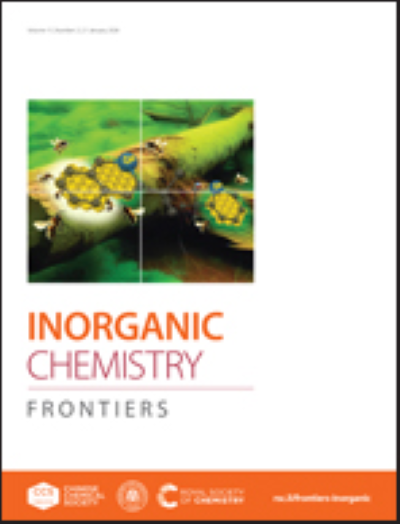Structural Disproportionation of Ag20Cu10 Highlights the Impact of Cluster Structure on Electrocatalytic Properties for CO2 reduction
IF 6.1
1区 化学
Q1 CHEMISTRY, INORGANIC & NUCLEAR
引用次数: 0
Abstract
Understanding the relationship between cluster structure and catalytic performance is fundamental for developing advanced cluster-based catalysts. The interactions between SbF6⁻ ions and metal nanoclusters prove particularly significant in modulating cluster structures and properties. Herein, we report the synthesis of a novel Ag20Cu10(Dppm)2(SAdm)14Cl8 (Ag20Cu10 for short) nanocluster featuring an Ag17 barrel-like core surrounded by an Ag3Cu10(Dppm)2(SR)14Cl8 shell. Upon introduction of NaSbF6, Ag20Cu10 undergoes structural disproportionation transformation to form superatomic alloy clusters [Ag8Cu12(Dppm)4(SAdm)8Cl8]2+ (2e and Ag8Cu12 for short) and [Ag17Cu15(SAdm)13(Dppm)3Cl9]2+ (8e and Ag17Cu15 for short). These three structures share similar staples and Ag-bridging atoms, indicating core recombination while maintaining peripheral motifs during transformation. Electronic structure analysis through density functional theory (DFT) calculations reveals distinct characteristics of these Ag-Cu nanoclusters. Evaluation of their CO2 reduction reaction (CO2RR) capabilities demonstrates superior catalytic performance of Ag20Cu10 compared to Ag8Cu12 and Ag17Cu15. This enhanced performance highlights the unique structural and electronic properties of Ag₂₀Cu₁₀, which enable more effective catalytic activity during the CO₂RR process. These findings emphasize the pivotal role of SbF6⁻ in modulating Ag-Cu nanocluster structures and highlight the impact of structural features on electrocatalytic performance.求助全文
约1分钟内获得全文
求助全文
来源期刊

Inorganic Chemistry Frontiers
CHEMISTRY, INORGANIC & NUCLEAR-
CiteScore
10.40
自引率
7.10%
发文量
587
审稿时长
1.2 months
期刊介绍:
The international, high quality journal for interdisciplinary research between inorganic chemistry and related subjects
 求助内容:
求助内容: 应助结果提醒方式:
应助结果提醒方式:


